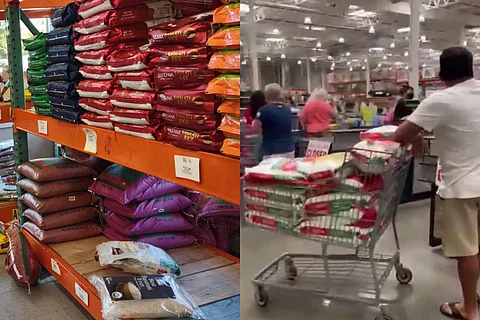

“Hey, did you hear about the rice shortage news? You need to go stock up right now!” was the panicked call 27-year-old Sowmya Akshara, a resident of Sacramento, California, received from a friend around 3 pm on Friday, July 21. Shortly after, she rushed to the local Indian grocery store only to be met with empty shelves. This was the plight of several others across the United States after the Indian government revised its export policy on Thursday to ban the export of certain varieties of rice.
The Ministry of Consumer Affairs, Food & Public Distribution prohibited export of non-basmati white rice, including semi-milled or wholly milled rice varieties, to “ensure adequate availability” and prevent inflation of rice prices domestically. India is the world’s largest exporter of rice, accounting for about 40% of rice sales worldwide. The country is also the second largest producer of rice after China. The ban also comes at a time when reports say that rice prices are at an all time high in nearly a decade.
Soon after the news came out, as early as Friday morning, consumers across the US thronged to Indian grocery stores and other shops where Indian rice varieties are sold. One video widely circulating across social media showed people checking out cartfuls of rice bags at the wholesale store Costco, which many have compared to the panic-buying of toilet paper rolls during the early days of the COVID-19 pandemic.
— Nimi Jayachandran (@nimeshika_j) July 22, 2023
In another video from Irving, Texas, a long queue was seen outside popular Indian grocery chain, Patel Brothers, which had begun to limit purchases in view of the situation.
After news broke that #India is ceasing exports of rice Indian groceries across the US on Friday saw hoards of people rushing to stock up, with some stores limiting the amount of rice people could buy #riceban #riceexportban via #TheCoconutCulture @dhanyarajendran @meghakaveri pic.twitter.com/X4q7nYCrTB
— Nimi Jayachandran (@nimeshika_j) July 22, 2023
“There was a long and winding line snaking through the aisles of India Cash and Carry, as people were hoarding bags of rice. Rice is a staple in our diet, and people are panicking that it may become unavailable or expensive later. Even though many of us have replaced Sona Masoori and Ponni with healthier options like Basmati or quinoa, many of us, especially older adults and children, prefer them since they’re better suited for traditional recipes,” said Rama Krishnamurthy, a homemaker from Morgan Hill, California.
This comes amid fears that the already high rice prices could be further inflated.
“I got a call from my daughter who lives on the east coast on Friday afternoon saying she and her husband weren’t able to get rice anywhere because shops had run out of stock. They asked us to go to the store and stock up. By the time we reached the store, the line was already so long so we didn’t know if we’d be able to get anything,” said 65-year-old Sumathi Kakarla, a homemaker from Houston, Texas. She also added that some stores had begun to limit the amount of rice to one bag per family, and at others, the prices had been raised from about USD 20 (approximately Rs 1,600) to USD 50 per bag (approximately Rs 4,000).
Residents in other states are worried as they have not been able to find any rice in any of the grocery stores or markets. “My friend who lives in Nashville suggested that I visit the Korean market or one of the other Asian grocery shops to see if rice is available there, as he had done that himself. I went to a Korean store in my neighbourhood, but they only had basmati rice and jasmine rice,” said 34-year-old Vivek Sharma, an IT professional who lives in Charlotte, North Carolina.
Though the Indian government stated that the ban is for non-basmati rice, in some places people have been rushing to buy basmati rice as well, out of the fear that they might not be able to get it at a later time.
“At my house we mostly use parboiled rice, which is apparently not on the ban list as of now, so we didn’t get too worried. We usually have an extra 10 pound bag (4.5 kg approximately) at home anyhow. I know many people are worried, but I don’t want to give in to the panic,” said Abhinav Chandra, a 45-year-old medical professional from Boston.
“As soon as I heard the news from a friend, I got really scared and placed an order for three saaku (large burlap bags). I can’t go without my thayir sadam (curd rice),” jokes Vidya S Chaudhari, a 32-year-old doctor from Atlanta, Georgia.
The news quickly also spread overseas to the United Kingdom, which also has a large Indian community; however, unlike in the US, residents don’t seem as concerned.
“I’m not too worried about the price surge. Since basmati rice is readily available in most grocery stores here, it seems to be the ideal workaround. Most South Asians that I know use the same. The inflation of general groceries in the UK doesn’t really give us the luxury to splurge much or pay a premium amount for existing stocks of Indian rice,” said 30-year-old Sanjana K, a resident of Plymouth in southern UK. She first heard the news of the ban and subsequent panic in the US through friends in a Plymouth social media group, most of whom shared her views on the situation.
This is not the first time that India has stopped rice export to foreign countries. In September 2022, the government banned export of broken rice and placed a 20% duty on certain rice varieties. This step was taken after parts of the country that produced the most amounts of rice witnessed poor rainfall.